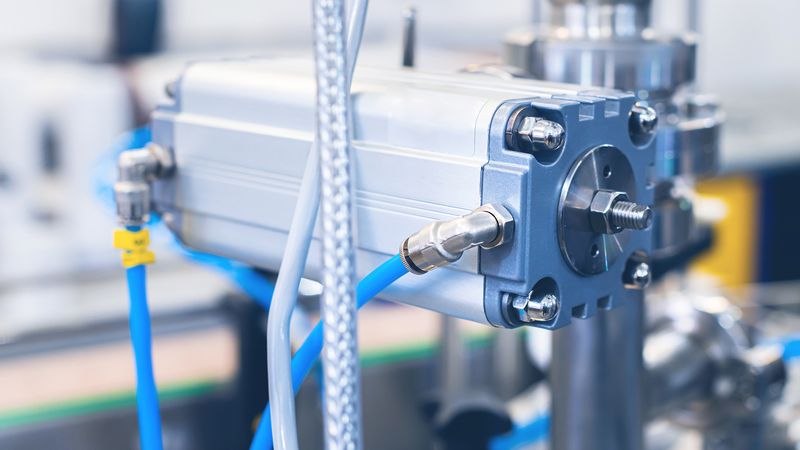Is Pneumatics Dying?
Manufacturing industry trends have seen a rise in the use of electric actuation over pneumatic, which has raised questions about whether pneumatic actuators are slowly being phased out.

Is Pneumatics Dying?
This article was first published on
www.rowse-pneumatics.co.ukActuators are responsible for moving mechanisms in a system. Pneumatic and electric actuators have similar structures, the main difference between them being their power source. Pneumatic actuators derive their power from compressed air pressure while electric actuators rely on electricity to power their functions.
To understand the appeal of using electric actuators over their pneumatic counterparts, we need to compare their features:
Pneumatic Vs Electric
Design
Pneumatic actuators feature a simpler and more compact design than electric actuators, which are built with more components such as motors and a ball screw. Despite pneumatic actuators being more lightweight, the components required to regulate airflow to operate them can increase their size and weight.
Speed
Pneumatic actuators operate with higher speed and lower force, but it’s difficult to maintain a consistent speed with compressed air. Pneumatic actuators are controlled manually, requiring specific adjustments to ensure the air force is accurate.
Electric actuators are operated through a program controller, giving the operator full control over speed when the device is in use. This is because electric actuators are powered by voltage, making them easier to moderate. In addition, the design of electric actuators with ball screws or pinion components reduces the gear ratio.
Accuracy
Although pneumatic actuators can provide high speeds and force, their accuracy is not as precise as electric actuators. As they are powered by compressed air, they have less accurate positioning, limiting their position applications. For this reason, pneumatic actuators are often selected for simpler tasks with end-to-end position requirements. Electric actuators by comparison are highly accurate with positioning capability down to 0.0025mm, making them very efficient.
Electric actuators have a clear advantage over pneumatic devices. Because of their electric power source, they provide more precision and dependability in repetitive functions. Given their high efficiency, electric actuators can be used with various position applications. Electric actuators typically use either servo or stepper motors. These motors feature advanced stop function reliability and more torque control to prevent position drifting.
Environment and Safety
Pneumatic actuators can handle hazardous or harsh environments better than electric devices because the latter’s electric components like sensors and motors are more sensitive. Pneumatics are also capable of handling a wider range of temperatures (-28 to 177 C) compared to electric actuators (-40 to 65 C). But pneumatic devices can still break down in high ambient temperatures if their air seals are damaged.
Electric actuators are affected by high heat, which erodes the bearing grease of the electric motor and metal expansion components, causing wear. There is also a concern about overheating with electric actuators because of their power source. Electric actuators are considered safer and more predictable for emergency stop functions because, unlike pneumatic devices, they don’t rely on air to hold a cylinder in position. Electric actuators also have a significant safety advantage because they automatically shut down if they experience an electrical short or overheat.
Electric actuators produce less noise than pneumatic devices, whose compressed air tanks generate more noise in the environment.
Costs and Maintenance
Pneumatic actuators are more affordable to purchase upfront, although their maintenance costs can build up over time. Part of these costs will be the electricity to run compressed air tanks and maintain them. Electric actuators have a higher outlay cost, but they are less expensive to power. They can save on operation costs in the long run because air power takes more maintenance and is not as effective as electric power.
Data Collection
With industry 4.0 tech paving the path for predictive maintenance and advanced automation, manufacturers are also seeking better data collection integration capacity. Electric actuators make it easier to collect data thanks to their in-built components and allow for enhanced real-time control. They are also compatible with many industrial network protocols used for communication (eg EtherNetIP, EtherCAT, Profinet). Pneumatic actuators have similar data monitoring capability although not to the same degree as electric actuators.
So Are Manufacturers Moving Away From Pneumatics?
Evaluating electric and pneumatic actuators side by side, it’s clear that electric actuators do have an advantage in performance and reliability. But pneumatic actuators are not redundant in the industry – the choice a manufacturer makes between pneumatic and electric actuators will be decided by their requirements. It’s also worth noting that pneumatic actuators are being developed to incorporate similar control features to electric actuators.
The choice of pneumatic or electric actuators is determined by the functions the device will carry out. Pneumatic actuators are suited to simple end-to-end positioning with a single axis. They are also preferable for functions that require limited motion profiles because pneumatic profiles are more difficult to change once configured.
For more complex functions that require high accuracy and dependability in repeating motion profiles, electric actuators are the better choice. They are also more efficient in emergency stop applications because of their precise torque control and speed variation capacity.
Whether a manufacturer chooses pneumatic actuators over electric devices is ultimately determined by a range of factors – notably accuracy, costs and long-term maintenance. Pneumatic actuators are cheaper upfront, but their upkeep and running costs do add up. Although electric actuators may appear to have more advantages, they do have higher costs and are not as capable of enduring harsh conditions as pneumatic components.
In conclusion, pneumatics are not redundant, they are just better suited to simpler functions. Economic factors such as the trend in cost reductions are influencing the choice manufacturers make, which accounts for the move to electric actuators. Saving energy while achieving high accuracy across a wide range of functions are two distinct advantages of using electric over pneumatic devices. Regardless of these benefits, pneumatic actuators will still be needed for specific cases.